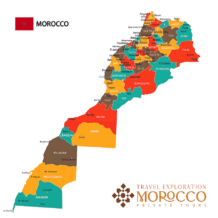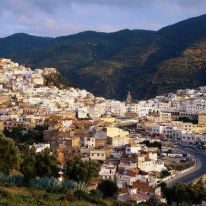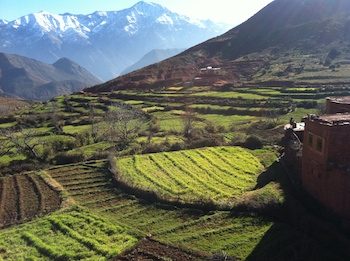
Hiking in Morocco offers a diverse tapestry of landscapes.
Some of Morocco’s Best Kept Secret Valleys and Seacoast Regions for Hiking are location in the provinces of Essaouira, Azilal, Al Haouz, Ifrane, Ourika and Chefchaouen. With its diversity of geography and landscapes, Hiking in Morocco offers a diverse tapestry of landscapes from the rugged High Atlas Mountains to ancient Berber villages, where well-worn trails wind through dramatic gorges and valleys, allowing trekkers to experience the country’s rich cultural heritage while surrounded by stunning natural beauty.
Morocco offers plenty of opportunities to hike and trek for both all ages and fitness levels. And even less experienced walkers need not miss out on the stunning coastal views, mountain panoramas and picturesque river valleys – there are many shorter or less challenging walks as well as the opportunity to trek on mule, camel or horseback. Here are five of Morocco’s best-kept scenic hiking destinations.

Essaouira Province: Cap Sim Coastal Trails
A longer stay in Essaouira offers the chance to get out of the medina and explore the surrounding countryside. The Cap Sim promontory, south of Essaouira and between the medina and the small seaside town of Sidi Kaouki, is reachable along the broad sandy beach when the tide is out. Given the prevailing trade winds from north to south, it is advisable to start in Essaouira and either organize a ride back from Cap Sim or the nearby village of Sidi Ouassane (beyond the lighthouse and home to a large wind farm) or continue to Sidi Kaouki (around 20km/12 miles along the beach from Essaouira) and pick up transport there, rather than turn back into the wind. Cap Sim can also be reached overland from the village of Ghazoua (8km/5 miles south of Essaouira). Walkers will be rewarded with views of deserted beaches, rock pools and caves and the occasional herd of goats grazing on the vegetation which clings to the windswept dunes and cliffs. The panorama is particularly attractive at sunset.
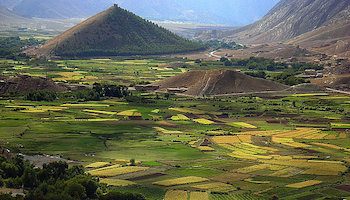
Azilal Province: The Happy Valley of Ait Bougemez
Beyond the city of Azilal, the Provincial capital, a road – only paved since 2001 – climbs up to Morocco’s so-called “Happy Valley” at Ait Bougemez. Remote and apparently untouched by many aspects of modern life, it is like a Moroccan Shangri-La. The Ait Bougemez Valley itself is a plateau in the High Atlas Mountains offering plenty of walks alongside babbling brooks where women wash their clothes, beside verdant green fields and under ancient walnut trees on the outskirts of small villages. Two cone-shaped peaks rise from the valley floor, one of which is home to the communal granary (agadir) of Sidi Moussa. It is a short, steep hike up to the granary, where a caretaker will happily show visitors around a small museum inside and up to the roof for the stunning views. For the more energetic, Ait Bougemez benefits from its proximity to M’Goun (Morocco’s 2nd highest peak after Mount Toubkal at 4,071m/13,350 ft) and its surrounding massif.
Al Haouz Province: Ourika Valley Adventures
Accessible on a day trip from Marrakech, the Ourika Valley is a very popular destination among Moroccans and tourists alike. Typically, day trippers visit the town of Setti Fatma in the valley to eat in a riverside restaurant and hike up to the seven waterfalls, which are easily reached with sturdy shoes via a combination of steps and scrambling over rocks. However, in the peak season this small town becomes overwhelmed with visitors. For those wishing to get off the beaten track and experience a more peaceful hike, Ait Ashok is a recommended destination. Hikers in the Ait Ashok area walk among fruit tree orchards fed by bountiful water flowing off the High Atlas Mountains and between small farming villages. In Spring, when the wind scatters the fruit blossom like snow, a trek is particularly pleasant. Later in the year, hikers can see the harvests of walnuts, almonds, apples and other fruits.
Ifrane Province: Morocco’s Swiss Mountains
The area around Ifrane, in the Middle Atlas Mountain range, is known as the Switzerland of Morocco, due to its altitude which results in snow and skiing in winter. The protected area of the Ifrane National Park covers an area of 500 km² (193 sq. mi) and although the last Atlas Lions are long gone, it is one of the last remaining habitats of the Barbary Macaque monkey. Hikers in this region walk among huge forests of Atlas Cedar, where the birdlife is unparalleled. Ornithologists can expect to see birds of prey such as the red kits and common kestrel and the lakes in the park also support several duck species.
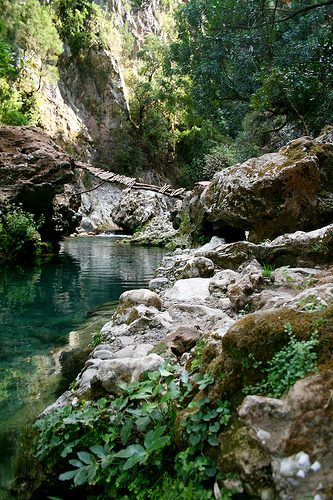
Chefchaouen Province: Talassemtane National Park
In the North of Morocco, in the foothills of the Rif Mountains and near the Mediterranean Coast, the area around the famous blue city of Chefchaouen is protected under the auspices of the Talassemtane National Park. The park covers some 145,000 hectares (358,000 acres). Hikers can either organize day hikes from Chefchaouen or undertake longer trekking excursions, staying within the park itself in a number of guest houses or in tents. The local environment is home to Rif Monkeys as well as countless native bird varieties and plant species, many of which are endangered. A popular destination for a day hike is the Akchour Falls and/or the Bridge of God. As long as the river is not in flood, various paths take walkers along the river banks and over a couple of hills. Routes can be selected according to fitness level and desired length of hike and in the peak season there are cafes on route where the weary can rest and enjoy a riverside tajine. The easiest hike is to God’s Bridge, a steep gorge at the base of which the river flows and which is spanned by a wooden bridge.
No matter your fitness level, Morocco’s diverse countryside of coasts, mountains and valleys is easily accessible and enjoyable. Hikes and walks of varying durations and challenge level can be arranged in many regions. It really is worth getting out of the cities to enjoy Morocco’s beautiful nature, stunning vistas and perhaps the hospitality of a rural Berber family along your route.
Written by Lynn Sheppard
For more information about Hiking in Morocco within the Essaouira Region
For more information about Hiking in Morocco within the Chefchaouen Region

